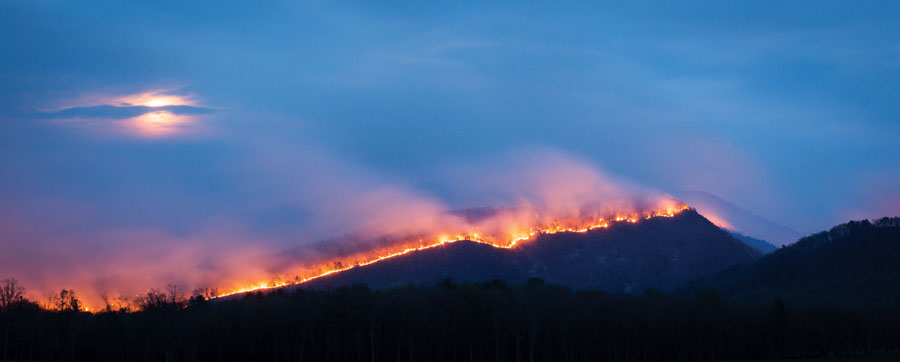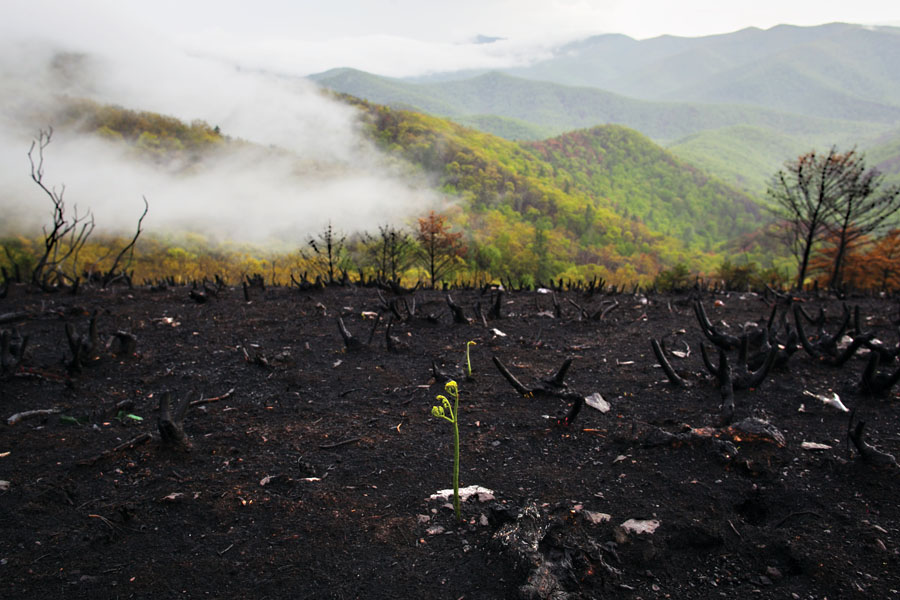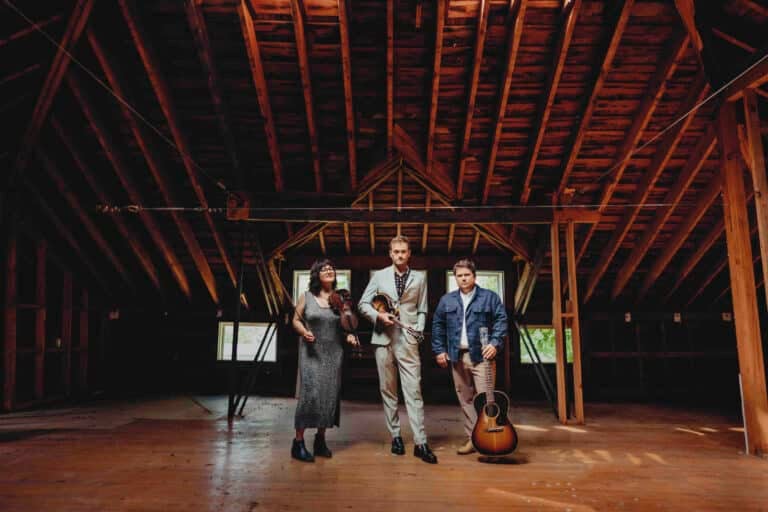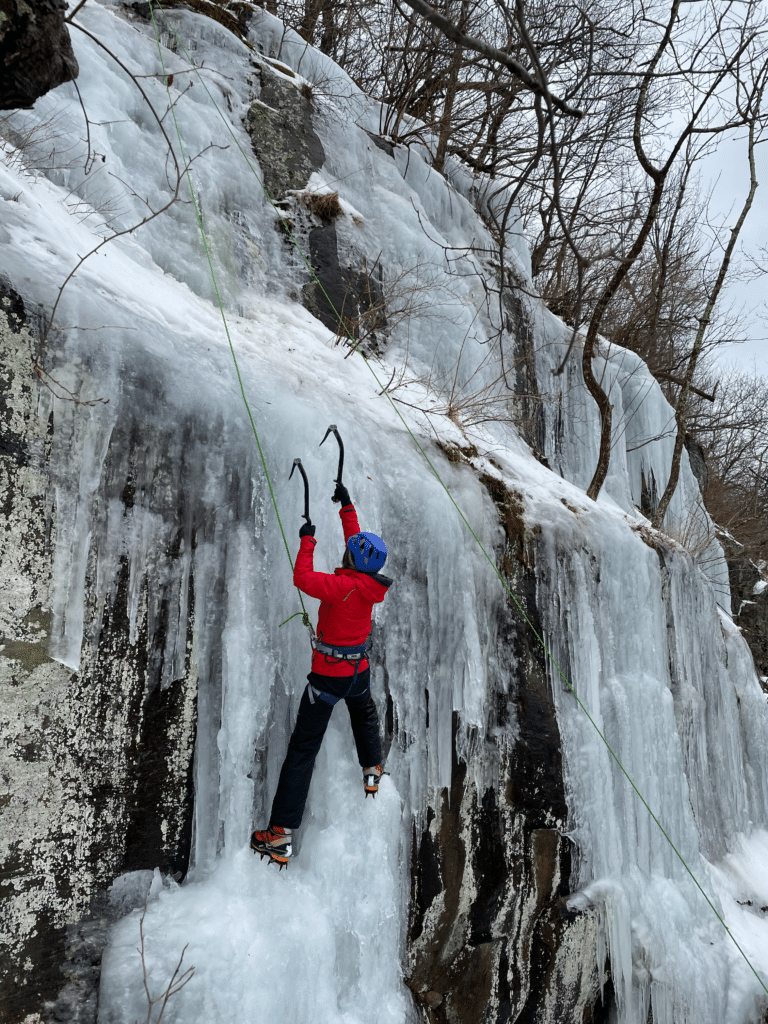The first reports of the fire in Shenandoah National Park arrived at 1:15 p.m. on Saturday, April 16, citing smoke several miles up the Rocky Mount Trail in the south district.
Shenandoah National Park Assistant Fire Management Officer Matt Way reported for work and hiked the Rocky Mount Trail from the park’s western boundary to find a 50-acre fire burning a few ridges below Skyline Drive.
The fire was too large and intense to make a safe direct attack with the few firefighters on site. Instead, Way worked with law enforcement officers to evacuate hikers from the trail, and he began to develop a suppression plan that would use additional resources and require clearance to use chainsaws and leaf-blowers—key tools to fighting eastern fires, but ordinarily prohibited in wilderness areas.
Driven by wind and burning through stands of mountain laurel, pine and oak, the fire rapidly grew. Way initially planned to use existing trail breaks to contain the fire, which had grown to more than 200 acres by the next morning. By day three, the fire had reached 2,000 acres. Crews headed down a trail to establish a fire line and halt the fire’s southern progress, but with the dry conditions and gusty wind that day, the fire beat them there and jumped the trail just as they arrived. Soon flames were racing up the ridge toward Skyline Drive.
The firefighters repositioned themselves to track the fire’s progress from the Brown Mountain overlook. What they saw was one of the fire’s most intense moments. Driven by winds and steep slopes, the fire roared up the mountain. It devoured leaf litter, dead snags, and mountain laurel in the understory, and when it hit drier pine stringers, it used the laurel as a ladder fuel to climb the trees, scorching them from top to bottom with 60-foot flames.
In just 20 minutes, the fire had climbed from the valley bottom to Skyline Drive. As it approached, the gusting wind lofted airborne firebrands to ignite spot fires on the other side of the road. Crews fell back to establish yet another fire line on the Appalachian Trail, which runs along the ridgetop above the road. This line held, but aided by winds, a lack of rain and low relative humidity, the fire continued to burn in other directions, including toward private property and houses to the north and west.
Park Superintendent Jim Northrup wrote in an open letter posted on Facebook:
“It is important for the public to understand that allowing the fire to come to these stopping points, where safe, defensible positions have been prepared, is not the same as ‘letting the fire burn’ out of control.”
The Rocky Mountain Fire of 2016 continued for another two weeks, burning 10,234 acres before officials declared it controlled in early May. It burned down to the park boundary on its north and west sides, and actually crossed the boundary into Beldor Hollow, but no structures were harmed. The Rocky Mountain Fire was only half the size of the 24,000-acre Shenandoah Complex fire of 2000, but it still ranks as park’s second largest fire in recent memory, and it serves as an example of how fire continues to play an important role in forests, even in the temperate rain forests of the Blue Ridge.

Fire plays a crucial role in the shape of the world, included with air, earth and water as one of the classical elements. Native Americans routinely used fire to make forests more productive for wildlife and game, effectively altering the ecology of Southern Appalachia. English settlers continued the trend, burning to open the understory, aiding in hunting and traveling, while also facilitating new plant growth for wildlife and domestic grazing animals. A 1908 report by a U.S. Senate committee reported that Appalachia “has suffered incalculable damage from fire, which in many localities still burns every year unchecked.”
Today, fire continues to do what it’s always done. But in an age of climate change, suburbanization, and ecological changes, the physical, cultural and political landscapes around fire have shifted along with the way we conceptualize it.
Much of that evolution has been framed by how public lands agencies manage fire. The U.S. Forest Service was still a fledgling institution in 1910 when it fought what became known as “the Big Blowup” on the Idaho-Montana border. The blaze burned more than a million acres in three days, creating its own weather, devouring entire canyons with giant fireballs, and forcing mass evacuations.
The Forest Service suffered a crushing defeat, yet the Forest Service’s creator and most outspoken champion, Gifford Pinchot, wove into a grand narrative numerous heroic moments by federal officials—running toward the fire when everyone else was fleeing, taking shelter in abandoned mine shafts and creekbeds, and helping evacuate towns in the fire’s path. This narrative both guaranteed the Forest Service’s survival and ensured it would spend decades focused primarily on fire suppression.
The Big Blowup’s veterans defined federal fire policy for decades to come: Willam Greeley emerged as Forest Service chief and prioritized fire suppression above all else. Meanwhile Elers Koch—whose obituary appeared in newspapers after the Big Blowup before he emerged from the forests still alive and with an intact crew—advocated for fire as an important component of forest health. For most of the century, Greeley’s views dominated federal policy, but over time, Koch’s influence grew as agencies began to recognize fire as a necessary ecological force, not only desirable but essential for many species of plants and animals. Smokey has been sending the wrong message: wildfire is as natural and necessary as rain for forest health.
Today, fire policy continues to evolve. The National Park Service and U.S. Forest Service both look for opportunities to let fire run when they can, as long as it doesn’t endanger firefighters or private property.
“We’re more populated in the East compared to the West, but that doesn’t mean we don’t have opportunities to achieve ecological objectives,” says Riva Duncan, fire management officer for North Carolina’s National Forests. “We look for opportunities. We had a fire last summer, an unusual lightning fire in summer without rain, that we were able to manage for multiple objectives. We got about 2,000 acres out of it.”
Allowing a fire to burn to accomplish ecological goals, however, must be weighed against other considerations, primarily the safety of crews and the proximity of private land and structures.
“We want a fire that we can pretty much keep it where we want it, providing good ecological effects, whether to soil, to wildlife, to vegetation, and certainly we want to minimize impacts to the public,” Duncan says. “Every single fire we really have to look at differently and decide if we can meet our objectives. If we don’t think we can, we’ll do our best to suppress it.”
In managing the spring fire in Shenandoah National Park, fire officials chose not to make a direct attack because it was difficult to do so on rugged terrain in unfavorable weather conditions without endangering firefighters. Instead, they pulled back and made a stand at defensible locations—roads, trails, natural barriers and constructed fire lines.
The fire strategy came about from prioritizing firefighter and public safety, but the Rocky Mountain Fire of 2016 still produced a wealth of ecological benefits.
In late June, two months after the fire was contained, its aftermath could still be seen in charred ground cover and scorched trees, but already sedges and ferns had reclaimed the forest floor, covering the charred-black ground with a vibrant green.
“This is pretty much what we’re going to see at this point in the game,” says Way. “There’s vegetation growing back. Mother Nature is going to heal the scars.”
Thin pine trees where the fire burned hottest were completely scorched, but National Park Service fire ecologist Missy Forder says the thick-barked pines are “pretty bombproof,” and even those that do die will likely be replaced, since they also released cones that rely on flames to reach the temperatures required for them to release seeds.
“The fire will have positive impacts on the vegetation and the wildlife,” Forder says. “It will regenerate those oaks and acorns. New, succulent vegetation that comes out pulls in wildlife. You’ll see different bird species, different animal species, things that haven’t been in that area because it’s been the same [ecological] structure. Fire alters it and makes it much more of a destination for different species.”
The same factors that make recently burned areas attractive for native plants and wildlife also create opportunities for invasive species, so biologists also must monitor them for exotics such as wavyleaf basketgrass, princess tree, and oriental bittersweet.
Not everyone is convinced of fire’s touted ecological effects. During the Shenandoah spring fire, residents along the park’s northern and western boundaries grew nervous as the flames grew closer. The various agencies involved in fighting the fire were able to use heavier equipment outside the park’s wilderness area, with the Virginia Department of Forestry pitching in with bulldozers to help cut fire lines.
In North Carolina, residents near Linville Gorge fought against a federal proposal for a prescribed burn. The burn, budgeted at about $4.5 million, would have been planned for 16,586 acres of mostly wilderness but also some areas near private land. Opponents formed Save Linville Gorge Wilderness as a chapter of the Blue Ridge Environmental Defense League and rallied public opposition, which succeeded in putting the project on hold, likely for good.
Lonnie Crotts, Save Linville Gorge Wilderness’s public engagement coordinator, argues that prescribed burning rarely improves the health of forests.
“Prescribed burning is driven by a supply of federal money that began in 2001 with ‘forest landscape restoration’ legislation under the George W. Bush administration,” Crotts wrote in an email. “This money provides much desired income to agencies such as the U.S. Forest Service and the National Park Service … which creates a bias for the ‘need’ for more fire in our environment.”
Crotts’ arguments against prescribed fire in the gorge include: concerns that human-caused fires may rage out of control; carbon release contributing to climate change; invasive species that thrive in burned areas and may cause more fire; air quality impacts made by the particulates released in fire; and threats to fire-sensitive endangered species.
Crotts also points to a 2012 fire in Croatan National Forest, near the North Carolina coast, that started as a prescribed burn but which spread to more than 20,000 acres. The fire didn’t threaten private property, but it did result in “code red” air quality warnings in three counties, and smoke could be smelled as far away as Raleigh.
The halting of prescribed burning in Linville Gorge doesn’t mean the end of fire there. Nearly 20,000 acres in the gorge have burned since 2000 from fires that weren’t planned (although three of the four fires during that time were human-caused).
Odds are fire that will strike Linville Gorge again. So long as they can keep firefighters safe and private property protected, federal officials are likely to let it burn.
“Because of the nature of topography there, it’s rare we can safely put people in the gorge to fight it,” Duncan says. “With fires in the gorge, we have to wait until it comes to us.”

Despite the impasse at Linville Gorge, the Forest Service and other land managers continue to conduct prescribed burns and manage unplanned fires for ecological goals when possible. In 2015, according to the National Interagency Fire Center (NIFC), fire crews conducted 37,263 prescribed burns that affected a total of 2.9 million acres, with state agencies accounting for about half of that, and the U.S. Forest Service for another third.
Overall, more than 10 million acres across the country burned in wildfires in 2015, according to the NIFC. In the Southeast—a large geographic area that includes southern Appalachia but also extends west to Texas—an average of 910,000 acres burn each year from human-caused fires and 224,000 acres from lightning-caused fires.
Most of those fires burned unevenly in a mosaic pattern, scorching some areas while leaving others relatively unscathed. The mosaic pattern left by fire aids in recovery, as vegetative heterogeneity leads to more biodiversity as different ecotypes overlap. That patchiness also can disguise the effects of fire, especially to an untrained eye observing a burned area just a few months afterward.
In Shenandoah National Park, land that was ablaze a couple of months ago is now covered in green, obscuring the ashes that still cover the ground. If one is closely watching the trail ahead or in deep thought, it’s possible to wander through a burned area without even noticing. That rapid recovery may also lull us into believing that fire has been eradicated from the landscape in which we live and play. But fire continues to shape the natural environment, as it has for millennia and as it will into the future, despite all efforts to eradicate and manage it.
WOMEN AND WILDFIRE
Arrive on the site of a wildfire and you’ll find fire engines, staffed by crews clad in yellow and green, lots of shovels and pulaskis, and the smell of smoke. One thing not likely to be present: A significant number of women.
Federal land agencies, traditionally dominated by men, have started to hire more women, including for leadership positions. Still, that progress hasn’t translated to wildfire jobs, according to numbers compiled by Brenda Dale, a U.S. Forest Service fire management officer. Women hold only 11 percent of permanent wildfire jobs in the Forest Service; by contrast they make up nearly 40 percent of its overall workforce. In the agency’s Southern region, only three women hold supervisory fire jobs, compared to 94 men.
Duncan says the numbers are getting worse instead of better.
“It’s something I scratch my head over all the time—there are fewer women now in fire than at any time in the last 15 years,” says Riva Duncan, fire management officer for North Carolina’s National Forests.
In the Southwest U.S., Bequi Livingston first joined a fire crew in 1979. She worked with wildfire for three decades, and in 2012, she established the Women in Wildland Fire program to pay her experiences forward
The program provides young women with fire training in a supportive environment, creating an opportunity to land a job on a seasonal fire crew. It also creates a foundation for its graduates to eventually work their way into leadership positions.
The eastern version of the Women in Wildland Fire program looks quite different than out West, however. Eastern fires tend to occur in the spring and fall, when dry leaf litter covers the ground, while western fires mostly happen in the summer. That means college students often can’t participate on a regular basis.
The few young women who do pursue fire training in the East often go west during the fire season. Duncan sees her job as providing the training and helping participants find opportunities, like one woman who trained in North Carolina and then joined a hotshot crew in California.
“We certainly look for young women who like physical challenges, are physically fit, who like the adventure,” Duncan says.
Related Content:








